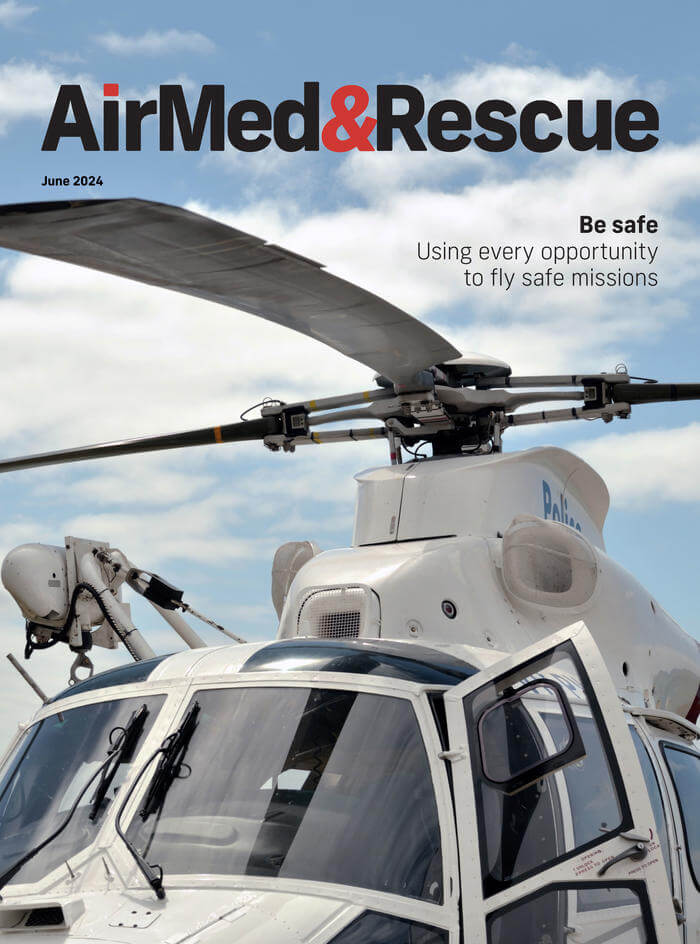Safety management systems: a successful marriage of humans and technology

Technology can transform safety management systems, but safety principles must also be embedded in company culture. Rob Coppinger finds out what technologies operators are using to ensure safety procedures are being thoroughly followed
Risk needs to be managed with the same level of priority as other core business processes in the effort to be a profitable enterprise, and technology and training are key.
“With advancements in technology, safety management systems have become more sophisticated and integrated, leveraging digital tools and platforms for enhanced efficiency and effectiveness,” explained Janita Wiedemann, Compliance Monitoring Manager at FAI Aviation Group.
Safety management systems (SMSs) exist to help organizations manage safety risk and assure the effectiveness of safety risk controls, and their practices and policies are set out in aviation regulators’ rules. These SMSs introduce what should be an evolutionary process in system safety and safety management, but they are still a formal, top-down, organization-wide risk management approach. The special missions that search and rescue (SAR) and air medical operators perform are inherently risky, so the SMSs need to be comprehensive, robust and regularly updated. This updating involves advancements in techniques, in-house training, consultancies or training firms, and technology.
“We use the software from Swiss49 for flight data monitoring and analysis, and iQSMS from ASQS for reporting, quality and risk management,” said Wiedemann. ASQS is an Austrian firm of computer scientists and its iQSMS solution is a web-based safety, quality and risk management system. While FAI uses software, Wiedemann points to how SMSs have evolved from “more rudimentary [practices], often relying on manual processes and documentation” to computers. The drivers of this change have stemmed from a “growing recognition of the importance of proactive safety management and continuous improvement within the aviation industry,” she added.
The part of this continuous improvement that has changed for air medical specialist Air Methods is how data is collected, stored and analyzed. “This has become much more automated, which makes it easier to visualize and share information, and, with the addition of artificial intelligence (AI), we are finding new ways to perform analysis,” said the company’s Vice President of Safety, Doug Downey. The ever-increasing amount of data made available for analysis and trend identification enables proactive risk management, according to Downey. In July 2021, Air Methods received its letter of acknowledgement from the Federal Aviation Administration accepting its SMS.
Regulatory requirements, industry standards, and a desire to mitigate risks and enhance safety culture have all played significant roles in shaping the evolution of the SMS. Wiedemann points to the technologies that have contributed to this. They include digital reporting systems for hazard identification and incident reporting, data analytics software for trend analysis and predictive modeling, mobile applications for real-time monitoring and reporting, and integrated management systems for streamlined compliance and risk management processes. Some of that technology can be onboard the aircraft.
As technology onboard aircraft, such as air ambulances, continues to advance, SMSs are likely to become more integrated with onboard systems
“Real-time data streaming from aircraft sensors, predictive maintenance capabilities, and enhanced communication channels between flight crews, operations centers [are involved],” said Wiedemann. “As technology onboard aircraft, such as air ambulances, continues to advance, SMSs are likely to become more integrated with onboard systems.”
Wiedemann also predicted that advancements in medical technology may necessitate updates to SMS protocols to address evolving risks and requirements specific to air medical operations. “Technology has played a crucial role in improving SMSs by providing tools for data collection, analysis, and communication,” said Wiedemann. “Yet it’s essential to recognize that technology is only as effective as the people using it.”
A good SMS is said by the industry to be about education, fostering a safety-oriented culture, and ensuring that processes are effectively implemented and followed. In Wiedemann’s view, when applying technology to SMS operations it is also crucial to strike a balance between innovation and reliability. “While technology offers immense potential for enhancing safety management, it must be implemented thoughtfully, with careful consideration given to training, usability, and system integrity,” she said. “Additionally, ongoing evaluation and adaptation of technological solutions are essential to ensure they remain aligned with evolving regulatory standards and industry best practices.”

Technology troubles
For Wiedemann, drawbacks to using technology in SMS implementation and management may include an over-reliance on technology at the expense of human judgment and critical thinking; the potential cybersecurity breaches; the cost implications associated with the adoption and maintenance of technological solutions; and personnel who are resistant to change. “Ultimately, the successful integration of technology into an SMS requires a holistic approach that prioritizes both technological advancements and human factors,” Wiedemann concluded.
Downey has seen advancements that require supplemental technological processes “supporting the human element of objective analysis and corrective action implementation”. The introduction of technology for SMSs ever since the 1990s has been focused on communicating safety reporting and managing that growing data set. “The ability to fuse countless data sources and sets is most effectively accomplished through software applications designed to do so, and eventually by integrating machine learning (aka AI) into the process,” he explained.
Aviation regulators inspect companies to ensure their SMSs are functioning properly. Transport Canada inspects aviation operations to make sure they meet safety regulations, and also inspects their SMSs to ensure they are working as intended. Transport Canada has also developed an SMS development guide for smaller aviation organizations to help small-sized operators implement an effective safety system. The department has several indicators that help measure safety performance, including the inspection regime, and accident and occurrence statistics.
Transport Canada is proposing amendments to the SMS requirements of the Canadian aviation regulations
Transport Canada is proposing amendments to the SMS requirements of the Canadian aviation regulations. This is to bring its rules into alignment with International Civil Aviation Organization (ICAO) standards and recommended practices. As SAR activities are considered ‘aerial work’, they will be part of the second of two distinct regulatory packages intended to modernize and expand SMSs in Canada. These changes are also being informed by the Transportation Safety Board of Canada’s recommendations concerning SMSs.
Whatever the rules, the reality is “it’s not one thing that causes accidents,” said Channel Islands Air Search Safety Officer Michael DeVon. Channel Islands Air Search is a voluntary organization providing a rapid response airborne SAR service in the Channel Islands’ waters. “We use a Swiss cheese model where it’s not until all those holes line up and the incident passes through all the holes [that the accident happens]. If one of those holes isn’t lined up, then it stops the accident from happening,” DeVon explained.
He has used the internet to find different reports and statistics on accidents and incidents to help develop their policies. “As a safety management officer, the main thing I use [the internet] for is data mining. I was able to use the internet to find [reports] and there was quite good information [there].” After an internal investigation, DeVon puts his recommendation to the safety review board and from there more recommendations can be generated. “Getting that [new information] disseminated to the crew, we use technology to disseminate that,” he added.

Change agent
“And then we use that technology [for] training,” DeVon continued. “We use technology to implement that [change] in our training. If it’s a change to the manual, then we use technology to distribute revisions to the manual revisions to checklists, things like that.”
Technology is also useful to monitor the effectiveness of the changes required by the new practices
Technology is also useful to monitor the effectiveness of the changes required by the new practices. “It can be used quite a bit for change monitoring,” DeVon said. “What has been the result? Over a period of time, has there been a decrease in incidence? Has there been an increase in incidence of the same nature?”
For DeVon, a good SMS is really about education and not technology, but “technology can help assure the correct application of SMSs”. “Technology is just one of the tools in your toolbox,” he said.
While SMS departments track everything, from the number of incident reports and whether they have been on the increase or on the decline, “a decrease in reports doesn’t necessarily mean a good thing,” DeVon commented. “It may just mean that people aren’t being as proactive.” This is why culture is so important in DeVon’s view. “What is the culture? Are you afraid that something’s going to happen to you if you report that you messed up? Well, we’re trying to reduce [that]. You want to eliminate as much as possible the idea that you’re going to be to blamed for something. If you make a mistake, we want to know about it because we want to prevent the next person down the line from making the same mistake.” DeVon saw AI as a good potential future tool as it is powerful software that can take data and identify the significance of trends without human intervention. The response to SMS non-compliance could be faster with a constant trend awareness.
Company culture and training
Based in Guadalajara, Mexico, AirLink Ambulance started more than 20 years ago. It provides bedside-to-bedside air ambulance transports and commercial medical escorts all year round for embassies, cruise lines and major insurance companies. AirLink’s SMS director is Oswaldo Hernandez Alcantara. He spoke to AirMed&Rescue through an AirLink operations engineer who acted as the interpreter. One innovation the company adopted that improved reporting was QR codes, explained Hernandez Alcantara. “Everybody has a card in his ID where you can scan a QR code. So, once you scan your QR code, you can send a report in Google Forms.”
With the Google Forms format, managers will receive the report immediately. The manager then replies to the report provider in an email, which can contain actions that can be taken to reduce any ongoing hazards. For AirLink, all the reports that are received are stored on Google Drive and analyzed. The company uses Microsoft Excel. “For the moment, we’re working with Excel with some data sheets [and this] helps the SMS to get all the analyses done.”
Hernandez Alcantara did not expect any new software systems to be adopted in the near future. There will be no software like iQSMS. The technology Hernandez Alcantara and his staff use is “quite simple”, as he puts it, “but very effective at the same time, because our organization is small”. AirLink places a lot of emphasis on training. “Once a year, we receive training about SMSs that gives examples from our company … examples [of] some hazards identified in the past, but in our company and applicable to us,” Hernandez Alcantara explained.
Ultimately, culture is the foundation for any safety system, with personnel abiding by the rules and practices that bitter experience has brought about
The annual training has been ongoing now for five years and is deemed one of the most important elements of the firm’s SMS. The training has been given to everyone in the company and includes examples of incidents at other air ambulance companies. It has to be applicable to AirLink’s operations, Hernandez Alcantara said. “They are helpful in enhancing the conscientiousness of the people that work here so, basically, they can say ‘okay, that can happen to us’. That’s a really good point of our training.”
Ultimately, culture is the foundation for any safety system, with personnel abiding by the rules and practices that bitter experience has brought about. Technology can help train people to embody safety culture; it can collect data and help with analysis. Training providers and consultancies can encourage improvement and innovation for companies’ SMSs, but it is the mindfulness of each and every employee through training and SMS awareness that is key.

May 2024
Issue
In our June edition, find out about the technology helping to make safety management better; learn about the tools that are reducing risks in flight; discover the challenges and problems facing the aerial firefighting community with suppressants and retardants; and read about what goes into electro-optical/infrared multi-sensor systems used by the police aviation sector; plus more of our regular content.
Rob Coppinger
Rob Coppinger is a veteran aerospace writer whose work has appeared in Flight International, on the BBC, in The Engineer, Live Science, the Aviation Week Network and other publications. He has covered a wide range of subjects from aviation and aerospace technology to space exploration, information technology and engineering. In September 2021, Rob became the editor of SpaceFlight Magazine, a publication by the British Interplanetary Society. He is based in France.

